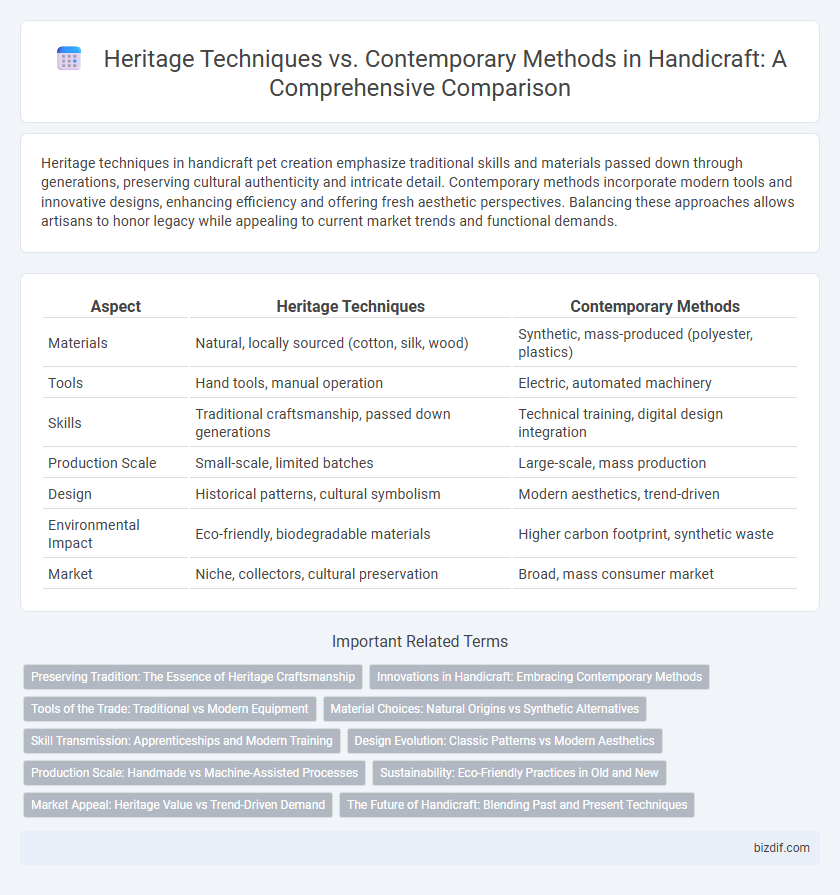Heritage techniques in handicraft pet creation emphasize traditional skills and materials passed down through generations, preserving cultural authenticity and intricate detail. Contemporary methods incorporate modern tools and innovative designs, enhancing efficiency and offering fresh aesthetic perspectives. Balancing these approaches allows artisans to honor legacy while appealing to current market trends and functional demands.
Table of Comparison
| Aspect | Heritage Techniques | Contemporary Methods |
|---|---|---|
| Materials | Natural, locally sourced (cotton, silk, wood) | Synthetic, mass-produced (polyester, plastics) |
| Tools | Hand tools, manual operation | Electric, automated machinery |
| Skills | Traditional craftsmanship, passed down generations | Technical training, digital design integration |
| Production Scale | Small-scale, limited batches | Large-scale, mass production |
| Design | Historical patterns, cultural symbolism | Modern aesthetics, trend-driven |
| Environmental Impact | Eco-friendly, biodegradable materials | Higher carbon footprint, synthetic waste |
| Market | Niche, collectors, cultural preservation | Broad, mass consumer market |
Preserving Tradition: The Essence of Heritage Craftsmanship
Heritage techniques in handicraft embody centuries-old skills passed down through generations, preserving cultural identity and traditional artistry. Contemporary methods often integrate modern tools and materials, enhancing efficiency while sometimes risking the dilution of authentic craftsmanship. Preserving tradition remains essential to maintaining the essence of heritage craftsmanship, ensuring that time-honored practices and cultural significance endure amid evolving techniques.
Innovations in Handicraft: Embracing Contemporary Methods
Innovations in handicraft increasingly embrace contemporary methods that integrate advanced tools and sustainable materials, enhancing precision and efficiency while preserving artistic integrity. Digital technologies like 3D printing and laser cutting revolutionize traditional craftsmanship by enabling complex, customizable designs that maintain cultural significance. These modern techniques coexist with heritage skills, fostering a dynamic evolution of handicraft that appeals to global markets and supports artisans' livelihoods.
Tools of the Trade: Traditional vs Modern Equipment
Traditional handicraft techniques employ hand tools such as chisels, looms, and wooden molds, preserving artisanal precision and cultural authenticity. Contemporary methods utilize advanced machinery like CNC routers, 3D printers, and electric kilns, enabling increased production speed and design complexity. The integration of traditional tools with modern equipment fosters innovation while maintaining the essence of heritage craftsmanship.
Material Choices: Natural Origins vs Synthetic Alternatives
Heritage techniques in handicraft prioritize natural materials such as cotton, wool, silk, and natural dyes derived from plants and minerals, ensuring authenticity and sustainability. Contemporary methods often incorporate synthetic alternatives like acrylic fibers, polyester blends, and chemical-based dyes that offer durability, colorfastness, and cost efficiency. The choice between natural origins and synthetic materials significantly influences the environmental impact, texture, and longevity of handcrafted products.
Skill Transmission: Apprenticeships and Modern Training
Heritage techniques in handicraft emphasize skill transmission through traditional apprenticeships, fostering deep hands-on learning and cultural continuity. Contemporary methods integrate modern training programs with digital tools to accelerate learning and expand accessibility. Combining both approaches ensures preservation of artisanal skills while adapting to evolving industry demands.
Design Evolution: Classic Patterns vs Modern Aesthetics
Heritage techniques in handicraft preserve classic patterns that showcase intricate detailing and cultural symbolism, reflecting centuries-old traditions. Contemporary methods integrate modern aesthetics through innovative materials and minimalist designs, emphasizing functionality alongside artistry. This design evolution bridges the authenticity of traditional craftsmanship with the sleek, experimental expressions of modern creativity.
Production Scale: Handmade vs Machine-Assisted Processes
Heritage techniques in handicraft prioritize handmade processes, preserving intricate craftsmanship and cultural authenticity but often resulting in limited production scale and higher labor intensity. Contemporary methods leverage machine-assisted processes to increase production efficiency and scale, enabling mass production while sometimes sacrificing the unique imperfections and artistic value inherent in handmade items. Balancing traditional craftsmanship with modern technology is crucial to sustaining cultural heritage while meeting market demands.
Sustainability: Eco-Friendly Practices in Old and New
Heritage techniques in handicraft often rely on natural materials and time-tested methods that minimize environmental impact, preserving cultural legacy while promoting sustainability. Contemporary methods integrate innovative eco-friendly technologies and recycled materials to enhance efficiency and reduce waste. Combining traditional craftsmanship with modern sustainable practices creates resilient, environmentally conscious products that honor the past and protect the future.
Market Appeal: Heritage Value vs Trend-Driven Demand
Heritage techniques in handicraft emphasize traditional craftsmanship and cultural authenticity, attracting buyers who value timeless quality and historical significance. Contemporary methods leverage innovative materials and modern design, appealing to trend-driven consumers seeking unique, fashionable products. Balancing heritage value with current market trends enhances product desirability and expands target audiences.
The Future of Handicraft: Blending Past and Present Techniques
Heritage techniques in handicraft preserve traditional skills such as hand embroidery and natural dyeing, ensuring cultural stories and artisanal quality endure through generations. Contemporary methods incorporate advanced tools like 3D printing and digital design, enhancing precision and expanding creative possibilities. Blending these approaches fosters innovation while maintaining authenticity, positioning handicraft for a sustainable future that honors its rich history.
Heritage Techniques vs Contemporary Methods Infographic

 bizdif.com
bizdif.com